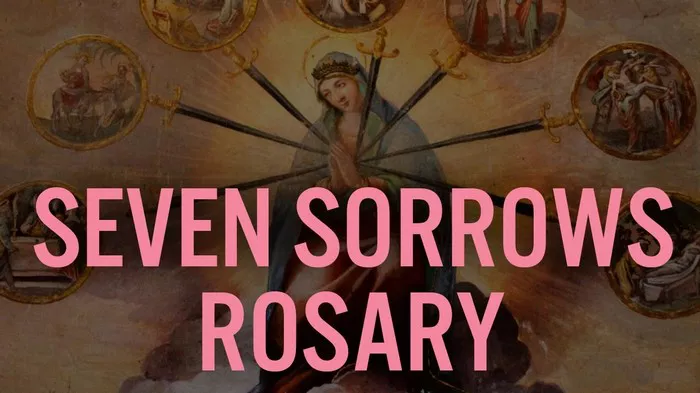In the vast tapestry of Catholic devotion, few practices are as poignant and profound as the Seven Sorrows. At its core, the devotion centers on meditating upon the seven key moments of sorrow in the life of Mary, the mother of Jesus, as foretold by the prophet Simeon in the Gospel of Luke. This spiritual journey invites believers to contemplate the depth of Mary’s suffering and her integral role in the salvation narrative.
Mary: A Figure of Unparalleled Significance
Within Catholic theology, Mary holds a unique position as the Mother of God, chosen to bear the Savior of humanity. Her journey from the Annunciation to the foot of the Cross is intricately woven into the fabric of salvation history. As such, her experiences are deeply intertwined with the mysteries of faith.
Origin and History of the Devotion
The roots of the Seven Sorrows devotion can be traced back to the early centuries of Christianity. However, it wasn’t until the Middle Ages that the devotion began to gain widespread popularity. St. Bridget of Sweden, a mystic and visionary, played a pivotal role in promoting devotion to the Seven Sorrows in the 14th century. Her revelations and writings further solidified the significance of Mary’s sorrows within Catholic piety.
Explanation of Each Sorrow
1. The Prophecy of Simeon:
The journey of Mary’s sorrows begins with the prophecy of Simeon, recounted in the Gospel of Luke (2:34-35). As Mary and Joseph present the infant Jesus in the temple, Simeon, a devout and righteous man, takes the child in his arms and offers a prophetic utterance. He speaks of Jesus as a sign that will be opposed and forewarns Mary of the sword of sorrow that will pierce her soul.
2. The Flight into Egypt:
Fleeing from the tyranny of King Herod, Mary, Joseph, and the infant Jesus embark on a perilous journey into Egypt. This flight is fraught with danger and uncertainty, as they seek refuge in a foreign land, far from the safety of their home in Nazareth.
3. The Loss of the Child Jesus in the Temple:
During the annual pilgrimage to Jerusalem, Mary and Joseph unknowingly leave behind the twelve-year-old Jesus. Their frantic search culminates in the discovery of Jesus in the temple, engaged in deep dialogue with the religious leaders. Mary’s relief at finding her son is tinged with the realization of the trials that lie ahead.
4. Mary Meets Jesus on the Way to Calvary:
As Jesus embarks on his final journey to Calvary, Mary encounters her son amidst the throngs of onlookers. The weight of the cross bears down upon Jesus, and Mary’s heart is rent with anguish as she witnesses his suffering.
5. The Crucifixion of Jesus:
At the foot of the cross, Mary stands as a witness to the ultimate sacrifice. Her son, the innocent Lamb of God, is crucified for the sins of humanity. In the midst of excruciating agony, Mary maintains her steadfast presence, united in love and sorrow.
6. Jesus is Taken Down from the Cross:
Following Jesus’ agonizing death, his lifeless body is tenderly removed from the cross and placed in Mary’s arms. In this moment of profound intimacy, Mary cradles her beloved son, embodying both the sorrow of loss and the tenderness of maternal love.
7. Jesus is Laid in the Tomb:
The lifeless body of Jesus is reverently laid to rest in the cold embrace of the tomb. Mary, along with a handful of faithful disciples, accompanies her son to his final resting place. The silence of the tomb echoes with the depth of Mary’s grief and the anticipation of the resurrection to come.
Observations and Practices
The Seven Sorrows are commemorated within the Catholic tradition through various feast days and devotional practices. The Feast of Our Lady of Sorrows, celebrated on September 15th, serves as a focal point for honoring Mary’s sorrows and seeking her intercession.
Central to the Seven Sorrows devotion is the Chaplet of the Seven Sorrows, a form of prayer that invites believers to meditate on each sorrow while reciting specific prayers. This chaplet serves as a tangible expression of devotion and a means of uniting one’s own sufferings with those of Mary.
For personal reflection and meditation, individuals are encouraged to contemplate the Seven Sorrows through the lens of their own lives. By identifying with Mary’s sorrows, believers can deepen their empathy for others and cultivate a spirit of compassion and solidarity.
Significance and Benefits of the Devotion
Meditating on the Seven Sorrows offers profound spiritual benefits for believers. By immersing oneself in Mary’s journey of sorrow, individuals can gain a deeper understanding of the redemptive power of suffering and the transformative nature of love.
Through the lens of Mary’s sorrows, believers are invited to confront the reality of human suffering and find solace in the assurance of God’s presence amidst the darkness. Mary’s unwavering faith and resilience serve as a beacon of hope for all who encounter trials and tribulations in life.
In embracing the Seven Sorrows devotion, believers are drawn into a deeper communion with Mary and her son Jesus. Through prayerful contemplation and reflection, individuals can experience a profound sense of healing and renewal, as they entrust their sorrows and burdens to the tender heart of Mary.
Conclusion
In conclusion, the Seven Sorrows devotion stands as a timeless expression of faith and devotion within the Catholic tradition. Through the contemplation of Mary’s sorrows, believers are invited to journey deeper into the mystery of redemption and to embrace the transformative power of love amidst the trials of life.

